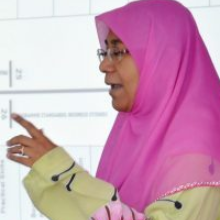
Z. Abu Bakar
Work place: Faculty of Computer & Information Technology, Al-Madinah International University Kuala Lumpur, 57100, Malaysia
E-mail: zainab.abubakar@mediu.edu.my
Website:
Research Interests: Information Retrieval, Natural Language Processing
Biography
Z. Abu Bakar is a professor of the Faculty of Computer & Information Technology, Al-Madinah International University (Mediu), Malaysia. She pursued her Ph.D. in 1999 from Universiti Kebangsaan Malaysia (UKM), Malaysia. Her research areas are Information Retrieval and Natural Language Processing. She has published more than two hundred research articles to national and international journals and conferences. She supervised numerous masters and Ph.D. students on their research as well.
Author Articles
Empowering Information Retrieval in Semantic Web
By Ahamed. M Mithun Z. Abu Bakar
DOI: https://doi.org/10.5815/ijcnis.2020.02.05, Pub. Date: 8 Apr. 2020
Until the inception of Web 1.0, the Information Retrieval was the center of the stage for library and it was defined as search and passive. Later on, the emergence of Web 2.0 was encouraged into the community, social interaction and user-generated content. Web 3.0 is a modern phenomenon and also known to “3D Web or the Semantic Web”, and it often used for specifically to formats and the technologies. The advanced Web 4.0 is the Ultra-Intelligent Agent Interactions between humans and machines. Semantic web technology finds meanings from various sources to enabling the machines and people to understand and share knowledge. The semantic web technology helps to add, change and implement the new relationships or interconnecting programs in a different way which can be as simple as changing the external model that these programs are shared. To give an information need, the semantic technologies can directly search, capture, aggregate, and make a deduction to satisfy the user needs. The paper presents a framework for knowledge representation assembling semantic technology based on ontology, semantic web, and an intelligent agent algorithm as a connectivity framework to share the appropriate knowledge representation which includes the web ontology language that discovers related information's from various sources to serve the information needs. The research addresses the intelligent agent algorithm is the key contribution that reveals appropriate information and empowers Web 3.0 and embraces Web 4.0 into the coming semantic web technology.
[...] Read more.The Impact of Web Contents Color Contrast on Human Psychology in the Lens of HCI
By Ahamed. M Mithun Z. Abu Bakar Wael. M. S. Yafooz
DOI: https://doi.org/10.5815/ijitcs.2019.10.04, Pub. Date: 8 Oct. 2019
Web contents include text, image, and any visual element that represents in web applications. Users conduct web applications throughout visual contents; therefore, the contents should visible clearly and follow a strict contrast ratio to differentiate from the other contents of the application. The color contrast assists to visualize contents combining the contrast ratio between background and foreground. Whether the web contents not visible clearly or overpass to split its color contrast from the background shall be worthless, and in addition, the human brain and psychology have an impact of colors which lead physiologically effects such as feelings and senses. Numerous web applications existing on the web and some applications failed to follow the design principles of Human-Computer Interaction (HCI). In HCI, visualization is the most widespread research area and, in the context of visual interaction, the HCI facilitates and guides application design that to be user-centric. This research reveals the HCI for color effects on the human eye, brain, phycology, and contrast ratio. Also extended the existing standard minimum contrast ratio for the design of web contents in light and dark background and foreground following HCI principles. The extended ratio experimented on a web application contents to differentiate the accuracy between the existing and the extended ratio.
[...] Read more.Other Articles
Subscribe to receive issue release notifications and newsletters from MECS Press journals